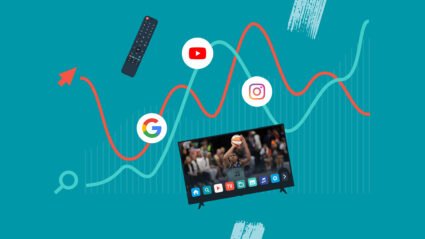The acceleration of digital channels across the last year has forced a long-foreseen reckoning for brands and how they invest, strategize, and deploy marketing in the upper funnel.
In short: over-indexing in “performance marketing” is going to hurt your brand. It’s essential to build your brand effectively to drive growth, but that upper funnel marketing should be powered by lower-funnel performance insights—which also ensures that all of your marketing is held accountable to overall business outcomes like incremental revenue, customer lifetime value (CLV), and profitable conversion.
This is known as full funnel activation.
We spoke with a true supergroup of marketing leaders from Avail, The Trade Desk, and Wpromote to explore how you can seize the opportunity to not just drive but create demand, from unsiloing your marketing channels and aligning media across the funnel to accurately attributing touchpoints at every stage of the customer journey.
To truly win the hearts of your customers, it’s not just about creating a united front across channels, but being there for people at every stage of the journey with long-term, value-driven engagements.
Today, the number one brand differentiator is no longer price or products: it’s the customer experience. Your customers expect so much more than just a seamless digital transaction—they want hyper-personalized, anticipatory experiences across every touchpoint and interaction with your brand.
Brands should follow these three strategies to ensure their experiences meet customers’ rising demands:
- Make brand awareness scores a key KPI for your organization, ideally using real-time analytics as opposed to a snapshot looking backwards from a point in time.
- Build a rich first-party data strategy, underpinned by a focused view of your customer, to activate better intent signals and behavioral insights across the funnel (more on that in the next section).
- Align individual and collective goals across the customer journey so any disconnects between functional silos like marketing, sales, and customer service are invisible to your end consumer.
“The consumer is in control of the experience, so it’s really about being in many places that makes sense for the type of journey they’re on—and recognizing that they no longer think about television as television, as print as print; they’re engaging with all of these channels.”
Leverage first-party data to align upper funnel efforts with conversion-focused campaigns.
Forward-thinking marketers know on an intuitive level that brand building and performance marketing are complementary activities that work together to achieve overall business goals. All marketing should perform, and all marketing should contribute to your brand story.
But to truly unify marketing and maximize efficiencies across the full continuum—marketers must start prioritizing their first-party data strategy. First-party data, or customer data that your company owns (with the consumer’s consent, of course), is the driving force for initiatives like gaining audience insights, creating personalized experiences, improving retargeting strategies, identifying patterns, and predicting future trends.
As key browsers and platforms usher in widespread changes to data privacy policies, marketers need to get much better at finding new ways to harness the power of their own data, and develop strategies to target on a one-to-one basis across the full funnel. Here are three data-driven strategies organizations can deploy to achieve more holistic marketing and a more seamless customer experience:
- Align on KPIs: When it comes to KPIs and budget planning, shared metrics are key to ensuring alignment of marketing activities with your core business objectives. It’s important to have defined processes around overall communication, planning, and budget processing to make sure your entire organization is driving in the same direction at all times.
- Bring your data insights under one roof: No single measurement tool can perfectly capture all media exposure, conversion, and sales data and give you ongoing actionable insights. To be successful, you’ll need to use a blended approach to measuring media impact across channels. For example, while attribution modeling tools are broadening to include some brand-building activities, they can still result in a skewed view of what’s really happening and the effect your campaigns are having on your business as a whole. Instead, attribution modeling and similar tools should be considered in concert with other forms of analytics, research, and testing.
- Take a holistic approach to budgeting: Overinvesting in lower funnel performance initiatives at the expense of brand building damages your brand’s ability to expand your customer base, drive emotional connections with customers, and truly maximize business results. Instead, think about how the two ends of the funnel can come together—and how you can leverage a fluid, flexible budget to zero in on actions that build toward your goals and scale business growth holistically.
“It’s crucial to understand that brand and performance work in synergy, each enhancing the other. There should never be friction: if you move money from brand to performance marketing because you think performance is working really well, the performance will likely start to decline. To truly drive the most value, you have to be flexible and fluid with your budget.”
Identify key attribution touchpoints at every stage of the customer journey.
Which channels should get credit for turning potential customers into purchasers—and how much credit should each channel get? As the customer journey grows more and more complex, understanding each touchpoint’s contribution can mean the difference between business success and marketing efforts that fail to deliver.
Ultimately, marketers have a number of ways to measure the impact of each touchpoint along the customer journey and to optimize campaigns to get the most value for their investments. Given that there is no one-size-fits-all solution to measuring marketing impact by channel, it’s best to take a blended approach tailored to your specific situation and objectives. Here are three popular methods to consider:
- Marketing Mix Modeling (MMM): Best for long-term decision making
- Many brands have historically relied on MMMs as the primary source to guide their resource allocation decisions. But because they’re based on past results and typically run annually, they’re unable to keep pace with the rapidly changing marketplace. This is why savvy brands employ additional methodologies, like multi-touch attribution and testing, that can provide more granular insights in real time.
- Multi-touch Attribution: Best for day-to-day optimizations and insights
- Data-driven attribution (DDA) is a type of multitouch attribution (MTA) that uses models to provide more actionable real-time insights than MMMs by continuously valuing the relative impact of different media channels. Data-driven attribution uses machine learning to determine how much credit to assign to each click in the customer journey, from the first time a customer engages with your brand to their final interaction before taking a desired action. It analyzes unique conversion patterns, comparing the path of customers who completed a desired action against those who did not, to determine the most effective touchpoints for each business.
- Experimentation: Best for validating new findings
- More sophisticated performance analysis requires the use of randomized controlled experiments to determine what drove each conversion—what’s also known as incrementality or lift. In other words, while attribution helps you correlate consumer behavior with conversions (and is a helpful tool in steering your marketing investments to get the biggest return), incrementality experiments use causal methodology to determine whether an ad actually changed consumer behavior. While experiments can take many forms, incrementality specifically relates to causality, which is not to be confused with measuring the impact of increases on an ad campaign’s budget, or A/B creative testing.
“While there is not one single perfect measurement tool out there, there are better ways to approach it that go beyond last-click. One way is using a very sophisticated multi-touch attribution model that algorithmically assigns credit to customer touchpoints, illuminating where spend is most and least effective.”







Responses